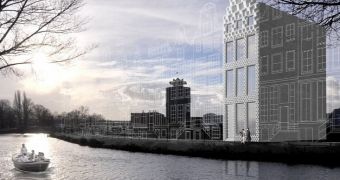Whenever word comes in about 3D printed buildings, we think about that gigantic 3D printer that can build a house out of concrete in 24 hours, but that's not what Dutch architects are using.
Instead, they are employing a large-scale version of a desktop 3D printer to make a home out of plastic parts that interlock.
Plastic might not be the best material to make a house out of, but there are enough types with high degrees of toughness that it can be pulled off.
The building is called 3D Print Canal House and it is made of what the builders call plastic blocks that can be made of recycled materials.
Besides the obvious benefits to the environment, the method allows the Dus Architects designers and hired help to build the home faster, and for less money since waste is eliminated and transportation costs are reduced. After all, they only need to bring in the plastic. The blocks are made on site.
The name of the printer is called KamerMaker (or "room builder") and was specifically invented for Dus Architects.
The Amsterdam building is the second 3D printed home, some might say. Previously, there was the "Landscape House" planned by Enrico Dini and Dutch architect Janjaap Ruijssenaars. It looks like a band, since it has a single surface.
The 3D Print Canal House is expected to be a lot more complex though, and easier to customize because while the interior and facade are printed as part of the same brick, spaces are left for wiring and pipes. Also, individual rooms can be remixed by the builders, even if they aren't architects.
So if, say, someone put an order for a home, the future owners could design their own ideal home, even “disconnect” the rooms and move the house if they suddenly decided to change residence.
It will take about three years’ time to finish the house, since the building will have 13 homes and only one three-meter-high corner segment has been raised so far.
Until then, the building site will be treated as a touristic attraction. Among others, President Barack Obama dropped by earlier this month (March 2014).
If the project turns out to be a success, plastic homes may become a thing of the future. Some might argue that plastic isn't exactly the best material for such large-scale objects, especially from an environmental standpoint, but then again, neither is concrete, and we won't even mention steel beams.

 14 DAY TRIAL //
14 DAY TRIAL //